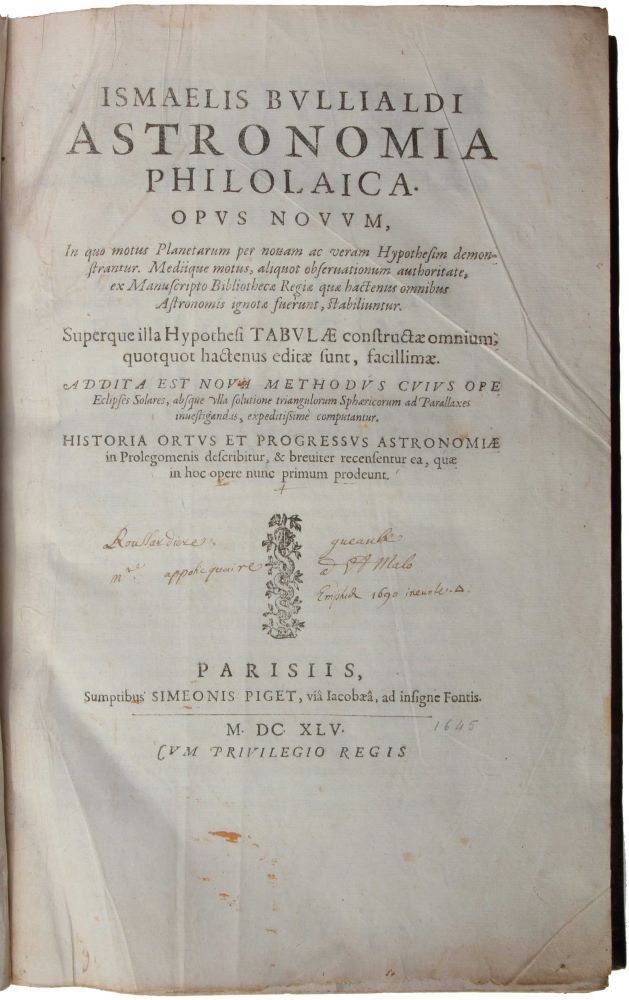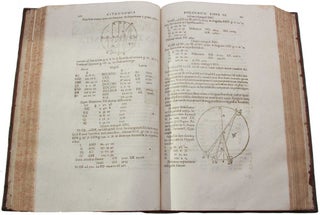Astronomia philolaica. Opus novum, in quo motus planetarum per novam ac veram hypothesim demonstrantur. Mediique motus, aliquot obseruationum authoritate, ex manuscripto Bibliothecae Regiae quae hactenus omnibus astronomis ignotae fuerunt, stabiliuntur ; superque illa hypothesi tabvlae constructae omnium, quotquot hactenus editae sunt, facillimae ; addita est nova methodvs cvivs ope eclipses solares, absque vlla solutione triangulorum sphaericorum ad parallaxes inuestigandas, expeditissimè computantur ; historia ortvs et progressvs astronomiae in prolegomenis describitur, & breuiter recensentur ea, quae in hoc opere nunc primum prodeunt.
Paris: Siméon Piget, 1645. First edition, very rare, of “the most important work on planetary systems between Kepler and Isaac Newton” (Robert Alan Hatch in Biographical Encyclopedia of Astronomers), “the first treatise after Kepler’s Rudolphine Tables to take elliptical orbits as a basis for calculating planetary tables” (Cambridge Companion to Newton), and the first to state that the planetary moving force “should vary inversely as the square of the distance—and not, as Kepler had held, inversely as the first power” (DSB). “An early Copernican and Keplerian, Ismael Boulliau was the most noted astronomer of his generation” (BEA). Newton read the present work closely and used it to rebut Robert Hooke’s claim to have been the first to perceive the inverse-square law of gravity (see below). ABPC/RBH record only the Macclesfield copy in the last twenty years (a copy in a later binding with rust holes through the text). “Astronomiaphilolaica clearly extended awareness of planetary ellipses. Here Boulliau offered an entirely new cosmology, a “newer than new” alternative to Kepler’s Astronomia nova. Boulliau began by attacking Kepler’s cosmology at its very foundation, systematically undermining the physical principles on which Kepler based his calculations. Boulliau concluded that Kepler’s celestial physics and calculational procedures were conjectural and cumbersome, unworthy of Kepler’s genius. Critical of Kepler’s assumptions and conclusions, Boulliau embraced elliptical orbits but insisted they could not be demonstrated by calculation alone. In place of Kepler’s anima mortrix and “celestial figments,” Boulliau argued it was simpler to assume that planets were self-moved, that their motion, imparted at creation, was conserved. In place of Kepler's indirect “a-geometrical methods” [the magnetic mechanisms hypothesized by Kepler to account for the eccentricity of the planetary orbits] Boulliau proposed direct calculation based on mean motion. “Boulliau’s solution to the “problem of the planets” was the conical hypothesis [described in the present work]. Because circles and ellipses are conic sections, Boulliau imagined that the planets moved along the surface of an oblique cone, each revolving in an elliptical orbit around the Sun located at the lower focus. By construction, the axis of the cone bisected the base, which at once defined the upper (empty) focus of the ellipse as well as an infinite number of circles parallel to the base. The position of a planet on the ellipse at any given time (Kepler’s problem) was thus defined by an intersecting circle, and hence, at any given instant, the motion of the planet was uniform and circular around its center (Plato’s Dictum). Where Kepler invoked a complex interplay of forces, Boulliau explained elliptical motion by reason of geometry; the planets naturally accelerated or decelerated due to the differing size of circles. Where Kepler employed indirect trial-and-error methods based on physics, Boulliau provided direct procedures based on geometrical principles. In context, Boulliau’s conical hypothesis was elegant and practical. Kepler’s construction – by contrast — was ingenious but useless … “Boulliau’s reputation reached its zenith during the 1660s in England … During this time Boulliau’s Philolaic Tables were widely copied, adapted, or imitated. In England, Jeremy Shakerley, among others, believed they were more accurate than Kepler’s, while in Italy, Riccioli demonstrated the claim for Saturn, Jupiter, and Mercury. Boulliau’s modified elliptical hypothesis also received accolades. Although he had proposed his own method, Nicolaus Kauffman (Mercator) continued to praise Boulliau’s model, claiming it could hardly be improved for accuracy. Not least, the “Ornament of the Century” offered praise. In his Principia (1687, Bk. III) Newton claimed that Kepler and Boulliau “above all others” had determined the periodic times of the planets with greatest accuracy” (BEA). Even before the publication of Principia, Newton had used Boulliau’s work in his dispute with Hooke over priority for the discovery of the inverse-square law of gravitation. “In his letter to Halley of June 1686, Newton claimed that he, Newton, established the ellipticity of the planetary orbits. In the Principia, the ellipticity of the orbits, as an empirical proposition, first emerged in Proposition 13 of Book III, where Newton asserted it as deducible from the inverse-square law of gravitation. Newton showed no sign of ever having read the Astronomia Nova. Whence his opinion that Kepler’s ellipse was merely a guess? “In a long postscript to his letter of 20 June 1686, Newton, in rebuttal to Hooke’s claim to originality in proposing the inverse-square law, cited a passage in Boulliau’s Astronomia Philolaica of 1645. Here Boulliau, in criticizing Kepler’s celestial physics, reviewed all the main Keplerian assumptions: Keplerian inertia; the Keplerian motive virtue issuing from the Sun to push the planets round, its intensity falling off directly as distance; the aligned magnetic fibers in the planets. “Kepler’s figment,” Boulliau concluded, “are the offspring of an extremely ingenious mind, most clever in contriving causes of things where the true causes are hidden. “Boulliau attacked Kepler particularly for choosing an inverse-distance variation for the solar virtue, rather than an inverse-square variation. Kepler had been the first to assign an inverse-square variation to light-intensity, on a priori grounds. Boulliau insisted that the same reasoning applies to the solar virtue. Newton in his postscript gave it as Boulliau’s view that “all force respecting the Sun as its center & depending on matter must be reciprocally in a duplicate ratio of the distance from the center.” Therefore, Hooke cannot claim the inverse-square law as his own invention. “To locate the statement he cites from Boulliau, Newton had to have read Boulliau’s entire critique of Kepler’s physics. This showed him that Kepler’s mechanics was mistaken. Kepler, therefore, could not know the orbits to be elliptical. Boulliau, on the very next page, spoke of Kepler’s choice of the ellipse as a “happy conjecture.” Perhaps that is an antecedent of Newton’s statement about Kepler’s having guessed the orbit to be elliptical. “It would not have occurred to Newton, I believe, to suppose that the ellipticity could be empirically established. An uncountable infinity of ovals neighbours on the correct ellipse; an infinity of them would fit the data” (Wilson, pp. 226-7). “An early Copernican and Keplerian, Ismael Boulliau was the most noted astronomer of his generation. The first surviving child of Calvinist parents, Ismael Boulliau (1583-1625), a notary and city official, and Susanna Motet (1582-1634), Boulliau began his studies in humanities at Loudun and after taking a law degree at Poitiers, he completed his studies in philosophy at Paris. Following his father’s death in 1625, Boulliau converted to Catholicism and moved permanently to Paris in 1632. During the next 30 years Boulliau enjoyed the patronage of the family De Thou and assisted the brothers Dupuy at the Bibliotheque du roi, home of the famous Cabinet Dupuy. Here Boulliau made lifelong friends with Pierre Gassendi and Marin Mersenne, met with René Descartes, Gilles Roberval, and Blaise Pascal, and established long-term relationships with learned visitors — among them Johannes Hevelius, Henry Oldenburg, and Christiaan Huygens — many becoming major correspondents. “Although he published numerous books and traveled widely in Holland, Germany, Poland, Italy, and the Levant Boulliau’s reputation as astronomer, mathematician, and classical scholar was largely due to his correspondence network. A pivotal figure in the Republic of Letters, Boulliau extended the humanist tradition of intelligencer to the New Science. His correspondence network, which rivaled the combined efforts of Mersenne and Oldenburg, tells us much about the New Science — much about the reception of Nicolaus Copernicus, Johannes Kepler, Galileo Galilei, Descartes and much about the complex communities that gave science shape. “Boulliau inherited an interest in astronomy from his father. Good evidence suggests Boulliau made astronomical observations by the age of 12, became enamored with astrology in adolescence, and by age 20 converted to Copernicanism. Mersenne proclaimed that Boulliau, by age 30, was “one of the most excellent astronomers of the century.” When Boulliau reached the age of 45, Gassendi bestowed upon him the singular title “premiere astronomer of the century.” Nominated astronomus profunda indaginis by Giovanni Riccioli in 1651, Boulliau enjoyed a remarkable reputation throughout his career … “From the beginning of his career Boulliau sought to reform and restore astronomy. This meant improving astronomical tables and perfecting the principles of planetary motion. Despite his much-discussed Platonism, Boulliau believed this reformation required fresh — not necessarily new — observations. Boulliau began by applying his skills as a classical scholar, by unearthing ancient observations of the Egyptians, Babylonians, Greeks, and others. His strategy — at once historical, empirical, and mathematical — was to establish a long base line of observations, and from these “general circumstances” of planetary motion, to determine their mean motions, thus exposing their deepest uniformities and most subtle inequalities. “In addition to his historical studies, Boulliau was a dedicated observer, maintaining detailed records from 1623 to 1687. Over the course of his career, Boulliau owned several of the best telescopes in Europe. More valuable than “diamonds and rubies,” they included an 11-ft. telescope, given to him by the Grand Duke of Tuscany in 1651, and later, thanks to friends, he obtained lenses from Huygens (a 22-ft. in 1659), T. L. Burattini (10- and 12-ft. in 1666), and Giuseppe Campani (1670). Active for over 60 years, Boulliau’s long-term interests, beyond the usual concern for eclipses and conjunctions, focused on the variable star Mira Ceti and lunar libration — Boulliau called the Moon’s second (synodic) inequality “evection,” a term still in use. Although he was not a first-rate observer, Boulliau was unrivaled in the Republic of Letters for coordinating astronomical observations, communicating data, and comparing results. “Despite his passion for observation, Boulliau is best remembered as a theorist. An outspoken Copernican and critical student of Kepler, Boulliau’s first book in astronomy aimed to supply new arguments for the motion of the Earth based on “Astronomy, Geometry, and Optics” and not “physical conjecture.” Although his Philolaus (Amsterdam, 1639) was published anonymously, the author was never in doubt, as Boulliau’s manuscript (De motu telluris, 1634) had circulated privately in the years immediately following Galilei’s condemnation. When the book finally appeared, it exerted an immense influence, spawning controversy across Europe that ranged from praise and envy to anger and rage. “Boulliau’s magnum opus [the present work] appeared 6 years later” (BEA). Sotheran I: 500 (“This important work according to Newton first mentions the sun’s attraction, which decreases in inverse proportion to its distance”); Favaro, Bibliografia Galileiana 205. Wilson, ‘From Kepler to Newton: Telling the Tale,’ in Dalitz & Nauenberg (eds.), The Foundations of Newtonian Scholarship, 2000.
Folio (364 x 233 mm), pp. [2], 3-22, [26: part titles]; 469, [1: blank]; 232 [tables] (title with some light creasing, old inscription to title), a fine and clean copy. Contemporary calf, spine richly gilt (hinges, capitals, and corners with almost invisible restoration).
Item #4954
Price: $13,500.00




